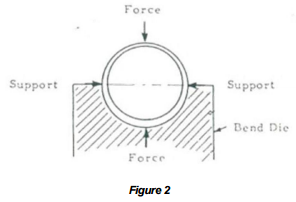When a tube or pipe is bent the bend area is usually flattened a bit. This means that the resulting bent pipe is no longer perfectly round, but is actually an oval shape. This tendency toward flattening is typically called ovality and is often a specification that must be controlled for when calculating a bend.
Controlling for ovality when pipe bending
Why do many applications require specific ovality tolerances? When the circumference of a bend is reduced, the flow through the tube is also reduced. When the ovality is very slight this reduction of flow is also minimal. For some applications, however, any reduction in flow is important to control for.
Determining just how much ovality can be tolerated can be difficult. For many applications, the ovality requirements are a matter of tradition. Conducting testing to determine the ovality can be time-consuming so many applications just specify the same ovality as similar projects in the past. Conducting the testing necessary to determine ovality can often lead to higher tolerances, however, so it is worth considering.
Maintaining shape with a mandrel during pipe bending
For applications were a tight bend radius and low ovality are required, one common solution is mandrel tube bending. When using a mandrel, the tube or pipe is pulled over a mandrel that is held in a fixed position. Some set ups also make use of a die to help maintain the shape of the tube (this is common for thinner walled tube and pipe or bends with a small radius).
The mandrel supports the tube wall through the bend, helping to prevent flattening, wrinkles, and kinks in the material. A mandrel can also help prevent spring back.
Pipe Bending Formula Guide
There is a lot of math that goes into a perfect bend. Click here to get your free copy of the Tube Section Modulus Calculator and Pipe Bending Formula Guide.

